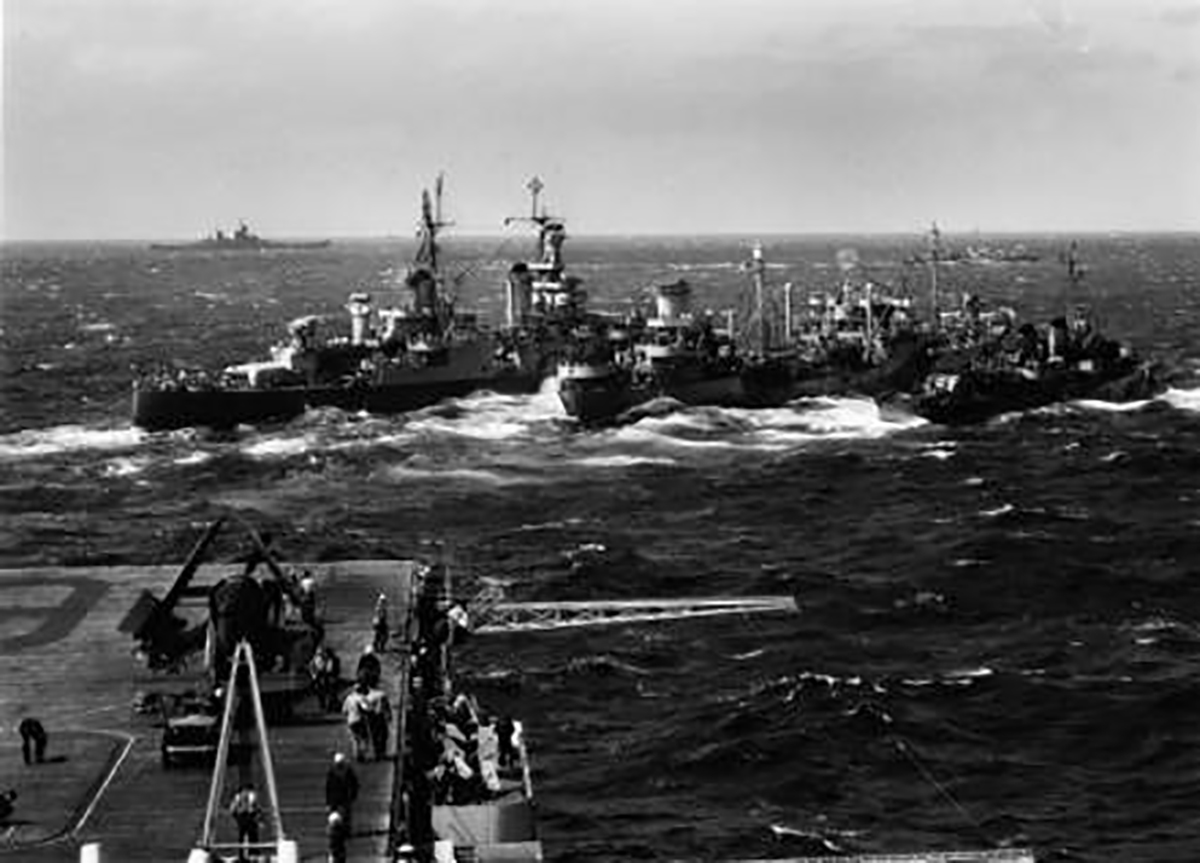
USS Indianapolis refueling at sea. Foreground: USS Essex (CV-9); Left to right: USS Indianapolis (CA-35), USS Atascosa (AO-66), USS Hank (DD-702). Background: Left to right: USS New Jersey (BB-62) and an unidentified Destroyer. Photo courtesy of the Indiana Historical Society, February 1945, Pacific Ocean (Iwo Jima)
Three ships have been named for the city of Indianapolis. The first Indianapolis, launched on July 4, 1918, was used by the Navy during WWI to carry supplies to Europe. The ship was decommissioned almost a year after it was first launched.
The second, and most famous, ship to be named for the capital city was the ill-fated heavy cruiser, christened by Lucy Taggart, daughter of former Indianapolis Mayor Thomas Taggart, in ceremonies on November 7, 1931, in Camden, New Jersey. In peacetime, the ship carried Secretary of the Navy Claude Swanson on an inspection tour of the Pacific in 1933, and took President Franklin D. Roosevelt on a goodwill cruise to South America in 1936.
During WWII the ship, commanded by Capt. Charles B. McVay III, served as the flagship for Adm. Raymond A. Spruance, Fifth Fleet commander. The Indianapolis and its crew of 1,196 men fought in campaigns at New Guinea, the Aleutian Islands, the Marianas Islands, and at Okinawa, where it was heavily damaged during a kamikaze attack.
On July 17, 1945, the ship left San Francisco for the Pacific island of Tinian carrying vital components for the atomic bomb, nicknamed “Little Boy,” that was dropped on Hiroshima. After safely delivering its vital cargo on July 26, the Indianapolis stopped at Guam before continuing unescorted to Leyte in the Philippines where it was to undergo training in preparation for the planned invasion of the Japanese home islands. Shortly after midnight on July 30, the ship was hit by three of six torpedoes fired from the Japanese submarine I-58. Without power, the ship was unable to radio for help and sank in just 12 minutes. Due to confusion at Leyte, the Indianapolis was not missed for several days. During that time, the 850 men who managed to escape from the sinking s hip had to go without water and were attacked repeatedly by sharks. On August 2, a Navy PBY plan finally spotted what were now only 318 Survivors.
The ship’s sinking, one of the worst disasters in US Navy history, produced years of controversy. Captain McVay was convicted at a December, 1945 court martial for failing to sail a zigzag course to elude enemy submarines. The Indianapolis tragedy has been the subject of numerous books, a 1981 play, Failure to Zigzag, produced by the Indiana Repertory Theatre in Indianapolis, and a 1991 TV movie. A granite and limestone memorial to the Indianapolis is situated on the east bank of the Central Canal (at approximately the 700 block of North Senate Avenue).
To commemorate the cruiser’s sinking, the Navy launched a Los Angeles-class nuclear attack submarine named for the city on July 30, 1977, in Groton, Connecticut. The submarine was christened by Mrs. William G. Bray of Indianapolis, wife of the Indiana congressional representative who had asked the Navy Department to name a ship for the city. Also on hand for the launching were 60 survivors of the WWI cruiser’s sinking.
Ray Boomhower, Indiana Historical Society.
Addendum: On August 19, 2017, a search team financed by Microsft co-founder Paul Allen located the wreckage of the sunken cruiser in the Philippine Sea lying at a depth of approximately 18,000 ft. On December 2018, the crew of the Indianapolis was collectively awarded a Congressional Gold Medal. (Wikipedia, https://en.wikipedia.org/wiki/USS_Indianapolis_(CA-35))

